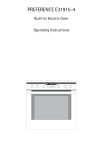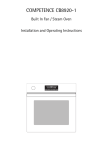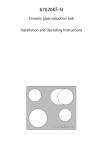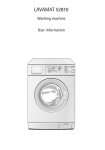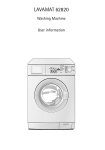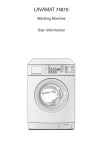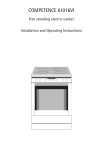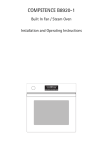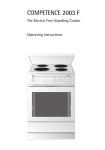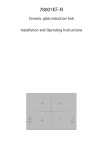Download AEG COMPETENCE E1100-4 User's Manual
Transcript
COMPETENCE E1100-4 Built-In Electric Oven User information Dear customer, Please read this User Information carefully and keep it to refer to at a later date. Pass this User Information on to any subsequent owner of the appliance. 1 3 2 2 The following symbols are used in the text: Safety instructions Warning: Notes that concern your personal safety. Attention: Notes that show how to avoid damage to the appliance. Useful tips and hints Environmental information Contents Operating Instructions . . . . . . . . . . . . . . . . . . . . . . . . . . . . . . . . . . . . . 5 Safety instructions. . . . . . . . . . . . . . . . . . . . . . . . . . . . . . . . . . . . . . . . . . . . . . 5 Disposal . . . . . . . . . . . . . . . . . . . . . . . . . . . . . . . . . . . . . . . . . . . . . . . . . . . . . . . 7 Description of the Appliance . . . . . . . . . . . . . . . . . . . . . . . . . . . . . . . . . . . . . General Overview. . . . . . . . . . . . . . . . . . . . . . . . . . . . . . . . . . . . . . . . . . . . . . . . Control Panel . . . . . . . . . . . . . . . . . . . . . . . . . . . . . . . . . . . . . . . . . . . . . . . . . . . Oven Features. . . . . . . . . . . . . . . . . . . . . . . . . . . . . . . . . . . . . . . . . . . . . . . . . . . Oven accessories . . . . . . . . . . . . . . . . . . . . . . . . . . . . . . . . . . . . . . . . . . . . . . . . 8 8 8 9 9 Before Using for the first time . . . . . . . . . . . . . . . . . . . . . . . . . . . . . . . . . . . 10 Setting and changing the time . . . . . . . . . . . . . . . . . . . . . . . . . . . . . . . . . . . . 10 Initial Cleaning. . . . . . . . . . . . . . . . . . . . . . . . . . . . . . . . . . . . . . . . . . . . . . . . . . 11 Using the Rings. . . . . . . . . . . . . . . . . . . . . . . . . . . . . . . . . . . . . . . . . . . . . . . . . 12 Setting the heat setting . . . . . . . . . . . . . . . . . . . . . . . . . . . . . . . . . . . . . . . . . . 13 Using the Oven . . . . . . . . . . . . . . . . . . . . . . . . . . . . . . . . . . . . . . . . . . . . . . . . . Switching the Oven On and Off . . . . . . . . . . . . . . . . . . . . . . . . . . . . . . . . . . . . Oven Functions. . . . . . . . . . . . . . . . . . . . . . . . . . . . . . . . . . . . . . . . . . . . . . . . . . Inserting the Shelf and Tray . . . . . . . . . . . . . . . . . . . . . . . . . . . . . . . . . . . . . . . Clock Functions . . . . . . . . . . . . . . . . . . . . . . . . . . . . . . . . . . . . . . . . . . . . . . . . . Switching Off the Time Display . . . . . . . . . . . . . . . . . . . . . . . . . . . . . . . . . 14 14 15 16 17 18 Uses, Tables and Tips . . . . . . . . . . . . . . . . . . . . . . . . . . . . . . . . . . . . . . . . . . . . Cooking table . . . . . . . . . . . . . . . . . . . . . . . . . . . . . . . . . . . . . . . . . . . . . . . . . . . Baking . . . . . . . . . . . . . . . . . . . . . . . . . . . . . . . . . . . . . . . . . . . . . . . . . . . . . . . . . Baking table . . . . . . . . . . . . . . . . . . . . . . . . . . . . . . . . . . . . . . . . . . . . . . . . . Roasting . . . . . . . . . . . . . . . . . . . . . . . . . . . . . . . . . . . . . . . . . . . . . . . . . . . . . . . Roasting table. . . . . . . . . . . . . . . . . . . . . . . . . . . . . . . . . . . . . . . . . . . . . . . . Grill Sizes . . . . . . . . . . . . . . . . . . . . . . . . . . . . . . . . . . . . . . . . . . . . . . . . . . . . . . Grilling table . . . . . . . . . . . . . . . . . . . . . . . . . . . . . . . . . . . . . . . . . . . . . . . . . Making Preserves . . . . . . . . . . . . . . . . . . . . . . . . . . . . . . . . . . . . . . . . . . . . . . . . 23 23 24 26 29 29 31 31 32 Cleaning and Care . . . . . . . . . . . . . . . . . . . . . . . . . . . . . . . . . . . . . . . . . . . . . . Outside of the appliance. . . . . . . . . . . . . . . . . . . . . . . . . . . . . . . . . . . . . . . . . . Oven interior . . . . . . . . . . . . . . . . . . . . . . . . . . . . . . . . . . . . . . . . . . . . . . . . . . . Accessories . . . . . . . . . . . . . . . . . . . . . . . . . . . . . . . . . . . . . . . . . . . . . . . . . . . . . Shelf Support Rails . . . . . . . . . . . . . . . . . . . . . . . . . . . . . . . . . . . . . . . . . . . . . . Oven Lighting . . . . . . . . . . . . . . . . . . . . . . . . . . . . . . . . . . . . . . . . . . . . . . . . . . . Oven Ceiling . . . . . . . . . . . . . . . . . . . . . . . . . . . . . . . . . . . . . . . . . . . . . . . . . . . . Oven Door. . . . . . . . . . . . . . . . . . . . . . . . . . . . . . . . . . . . . . . . . . . . . . . . . . . . . . Oven door glass . . . . . . . . . . . . . . . . . . . . . . . . . . . . . . . . . . . . . . . . . . . . . . . . . 34 34 34 34 35 36 37 38 39 3 What to do if … . . . . . . . . . . . . . . . . . . . . . . . . . . . . . . . . . . . . . . . . . . . . . . . . 40 Installation Instructions . . . . . . . . . . . . . . . . . . . . . . . . . . . . . . . . . . . 41 Safety information for the installer. . . . . . . . . . . . . . . . . . . . . . . . . . . . . . . . . 41 Guarantee Conditions. . . . . . . . . . . . . . . . . . . . . . . . . . . . . . . . . . . . . . 45 Customer Service Centres . . . . . . . . . . . . . . . . . . . . . . . . . . . . . . . . . 46 Service 4 . . . . . . . . . . . . . . . . . . . . . . . . . . . . . . . . . . . . . . . . . . . . . . . . . . . . . . 47 Operating Instructions 1 Safety instructions 5 This appliance conforms with the following EU Directives: – 73/23/EEC dated 19.02.1973 Low Voltage Directive – 89/336/EEC dated 03.05.1989 EMC Directive inclusive of Amending Directive 92/31/EEC – 93/68/EEC dated 22.07.1993 CE Marking Directive Electrical safety • This appliance must be only connected by a registered electrician. • In the event of a fault or damage to the appliance: Take the fuses out or switch off. • Repairs to the appliance must only be carried out by qualified service engineers. Considerable danger may result from improper repairs. If repairs become necessary, please contact our Customer Services or your dealer. Child Safety • Never leave children unsupervised when the appliance is in use. Safety whilst Using • This appliance is intended to be used for cooking, roasting and baking food in the home. • Take care when connecting electric appliances to sockets nearby. Do not allow connecting leads to come into contact with or to catch beneath the hot oven door. • Warning: Risk of burns! The interior of the oven becomes hot during use. • Using ingredients containing alcohol in the oven may create an alcohol-air mixture that is easily ignited. In this case, open the door carefully. Do not have embers, sparks or naked flames in the vicinity when opening the door. 3 Information on acrylamides According to the latest scientific knowledge, intensive browning of food, especially in products containing starch, can constitute a health risk due to acrylamides. Therefore we recommend cooking at the lowest possible temperatures and not browning foods too much. 5 How to avoid damage to the appliance • Do not line the oven with aluminium foil and do not place baking trays, pots, etc. on the oven floor, as the heat that builds up will damage the oven enamel. • Fruit juices dripping from the baking tray will leave stains, which you will not be able to remove. For very moist cakes, use a deep tray. • Do not put any strain on the oven door when open. • Never pour water directly into the oven when it is hot. This could cause damage to or discoloration of the enamel. • Rough handling, especially around the edges of the front panel, can cause the glass to break. • Do not store any flammable materials inside the oven. These could ignite when the oven is switched on. • Do not store any moist foods inside the oven. This could damage the oven enamel. 3 6 Note on enamel coating Changes in the colour of the oven’s enamel coating as a result of use do not affect the appliance’s suitability for normal and correct use. They therefore do not constitute a defect in the sense of the warranty law. Disposal 2 2 Packaging material The packaging materials are environmentally friendly and can be recycled. The plastic components are identified by markings, e.g. >PE<, >PS<, etc. Please dispose of the packaging materials in the appropriate container at the community waste disposal facilities. Old appliance W 1 The symbol on the product or on its packaging indicates that this product may not be treated as household waste. Instead it shall be handed over to the applicable collection point for the recycling of electrical and electronic equipment. By ensuring this product is disposed of correctly, you will help prevent potential negative consequences for the environment and human health, which could otherwise be caused by inappropriate waste handling of this product. For more detailed information about recycling of this product, please contact your local city office, your household waste disposal service or the shop where you purchased the product. Warning: So that the old appliance can no longer cause any danger, make it unusable before disposing of it. To do this, disconnect the appliance from the mains supply and remove the mains cable from the appliance. 7 Description of the Appliance General Overview Control panel Door handle Full glass door Control Panel Temperature Pilot Light Time display Clock function buttons Temperature selector Oven Functions 8 Hob Cooking Zone Control Knobs Oven Features Top heat and heating elements Oven lighting Shelf positions Bottom Heat Oven shelf runners, removable Oven steam vent The steam from the oven is fed directly upwards via the duct in the rear of the cooking surface. Oven accessories Combination shelf For dishes, cake tins, items for roasting and grilling. All-purpose tray For moist cakes, roasts or for use as a baking tray or a pan to collect fat. 9 Before Using for the first time Setting and changing the time 3 The oven only operates when the time has been set. When the appliance has been connected to the electrical supply or when there has been a power cut, the function indicator Time flashes automatically. 1. To change a time that has already been set, press the Selection button repeatedly until the function indicator Time flashes. 2. Using the or button, set the current time. After approx. 5 seconds, the flashing stops and the clock displays the time set. 3 10 The appliance is now ready to use. The time can only be changed if no automatic function (Cook time or End time ) has been set. Initial Cleaning 1 3 Before using the oven for the first time you should clean it thoroughly. Caution: Do not use any caustic, abrasive cleaners! The surface could be damaged. To clean metal fronts use commercially available cleaning agents. 1. Turn the oven function switch to oven lighting . 2. Remove all accessories and the shelf support rails and wash them with warm water and washing up liquid. 3. Then wash out the oven with warm water and washing-up liquid, and dry. 4. Wipe the front of the appliance with a damp cloth. 11 Using the Rings 3 Also refer to the operating instructions for your built-in hob. It contains important information on ovenware, operation, cleaning and care. Heat settings • You may select the heat settings within the range of settings 1-9. • Intermediate positions may be selected between settings 2 and 7. 2 1 = lowest heat setting 9 = highest heat setting Switch the cooking zone off approx. 5-10 minutes before cooking is finished to make use of the residual heat. This saves electricity. front left rear left rear right Hob Cooking Zone Control Knobs 12 front right Setting the heat setting 1. Select the heat setting. 2. To end the cooking process, turn back to the Off position. 13 Using the Oven Switching the Oven On and Off Temperature Pilot Light Temperature selector Oven Functions 1. Turn the oven functions dial to the desired function. 2. Turn the temperature selector to the desired temperature. The temperature pilot light is lit as long as the oven is heating up. 3. To turn the oven off, turn the oven functions dial and the temperature selector to the OFF position. 3 14 Cooling fan The fan switches on automatically in order to keep the appliance’s surfaces cool. When the oven is switched off, the fan continues to run to cool the appliance down, then switches itself off automatically. Oven Functions The oven has the following functions: Oven function Application Heating element/ fan Light Using this function you can light up the oven interior, e.g. for cleaning. --- Conventional For baking and roasting on one oven level. Top heat, bottomheat Top heat For browning bread, cakes and pastries and for bakes. Top heat Bottom heat For baking cakes with crispy or crusty bases. Bottom heat Grill For grilling flat foodstuffs placed Grill in the middle of the grill and for toasting. Dual gril For grilling flat foodstuffs in Grill, top heat large quantities and for toasting. 15 Inserting the Shelf and Tray 3 Anti-tip device All slide-in units have a small bulge on the left and right. This bulge is an anti-tip device and must always point to the rear of the oven. Inserting tray: The anti-tip device must point towards the rear of the oven. Inserting shelf: Insert the shelf unit with both guide rails pointing upwards. The anti-tip device must point downwards and be positioned to the rear of the oven compartment. Inserting shelf and tray: When using the shelf and the tray together, insert the shelf’s anti-tip device exactly into the indentations in the tray. 16 Clock Functions Function Indicators Button Time display Function Indicators Selector Button Button Countdown To set a countdown. A signal sounds after the time has elapsed. This function does not affect the functioning of the oven. Cook time To set how long the oven is to be in use. End time To set when the oven is to switch off again. Time To set, change or check the time (See also section “Before Using for the First Time”). 3 How to use the clock functions • After a function has been selected, the corresponding function indicator flashes for about 5 seconds. During this period, the desired times can be set using the or button. • When the desired time has been set, the function indicator continues to flash for approx. 5 seconds. After that the function indicator is then lit. The set time begins to run. • Press any of the buttons to stop the audible signal. • The desired oven function and temperature can be selected before or after the clock functions Cook time and End time are set. • When the cooking process is completed, turn the oven function dial and the temperature selector back to the OFF position. 17 2 Switching Off the Time Display By switching off the time display you can save energy. Switching off the time display Press and hold down any two buttons until the display becomes dark (approx. 10 seconds). 3 18 Switching on the time display Press and hold down any two buttons until the time reappears in the display (approx. 10 seconds). The display can only be switched off if none of the clock functions Cook time , End time or Countdown is in use. Countdown 1. Press the Selection button repeatedly until the function indicator Countdown flashes. 2. Using the or button set the desired Countdown (max. 2 hours 30 minutes). After approx. 5 seconds the display shows the time remaining. The function indicator Countdown lights up. When the time has elapsed, the function indicator flashes and an audible signal sounds for 2 minutes. The signal can be stopped by pressing any button. 19 Cook time 1. Press the Selection button repeatedly until the function indicator Cook time flashes. 2. Using the or button set the desired cooking time. After approx. 5 seconds the display returns to showing the current time. The function indicator Cook time lights up. When the time has elapsed, the function indicator flashes, an audible signal sounds for 2 minutes and the oven switches itself off. 3. The signal and the programme can be stopped by pressing any button. 20 End time 1. Press the Selection button repeatedly until the function indicator End time flashes. 2. Using the or button set the desired switch-off time. After approx. 5 seconds the display returns to showing the current time. The function indicator End time lights up. When the time has elapsed, the function indicator flashes, an audible signal sounds for 2 minutes and the oven switches itself off. 3. The signal and the programme can be stopped by pressing any button. 21 3 Cook time and End time combined Cook time and End time can be used simultaneously, if the oven is to be switched on and off automatically at a later time. 1. Using the Cook time function, set the time required for cooking the dish. In this example, 1 hour. 2. Using the End time function, set the time at which the dish should be ready. In this case 14:05:00. The function indicators Cook time and End time light up and the current time is shown in the display. In this case 12:05. The oven switches on automatically at the time calculated. In this case, at 13:05:00. And switches itself off again when the cooking time entered has elapsed. In this case, at 14:05. 22 Uses, Tables and Tips Cooking table The information given in the following table is for guidance only. Heat setting Cookingprocess Cooking time Tips/Hints Residual heat, Off position 0 1 suitable for Keeping food warm Keeping cooked foods warm as required Cover Melting Hollandaise sauce, melting butter, chocolate, gelatine 5-25 mins. Stir occasionally Solidifying Fluffy omelettes, baked eggs 10-40 mins. Cook with lid on 1-2 Simmering rice and milkAdd at least twice as based dishes much liquid as rice, stir 25-50 mins. Heating up ready-cooked milk dishes part way meals through cooking 2-3 Simmering on low heat 3-4 Steaming Steaming vegetables, fish 20-45 mins. Braising braising meat 4-5 With vegetables add only a little liquid (a few tablespoons) Steaming potatoes 20-60 mins. Use only a little liquid, e. g.: max. ¼ l water for 750 g potatoes Cooking larger quantities of food, stews and soups 60-150 mins. Up to 3 l liquid plus ingredients Steady frying Turn halfway through cooking 5-15 mins. per pan Turn halfway through cooking Boiling 6-7 Gentle Frying Frying escalopes, veal cordon bleu, cutlets, rissoles, sausages, liver, roux, eggs, pancakes, doughnuts 7-8 Heavy Frying Hash browns, loin steaks, steaks, Flädle (pancakes for garnishing soup) 9 Boiling Searing Deep frying Boiling large quantities of water, cooking pasta, searing meat (goulash, pot roast), deep frying chips 23 3 1 We recommend when boiling or searing foods using the highest heat setting at first and then letting foods requiring a longer cooking time finish cooking on the desired heat setting. Overheated fats and oils can ignite quickly. If you are cooking foods in fat or oil (e.g. chips), remain nearby. Baking Oven function: Conventional Baking tins For Conventional dark metal and non-stick tins are suitable. Oven levels Baking with Conventional 1 baking tray: e.g. oven level 3 1 cake tin: e.g. oven level 1 24 is only possible on one level. 3 2 General Instructions • Insert the tray with the bevel at the front. • With Conventional you can also bake with two tins next to one another on the oven shelf at the same time. This does not significantly increase the baking time. When frozen foods are used the trays inserted may distort during cooking. This is due to the large difference in temperature between the freezing temperature and the temperature in the oven. Once the trays have cooled the distortion will disappear again. How to use the Baking Tables The tables give the required temperature settings, baking times and oven shelf levels for a selection of typical dishes. • Temperatures and baking times are for guidance only, as these will depend on the consistency of the pastry, mixture or dough and the number and the type of baking tin. • We recommend using the lower temperature the first time and then if necessary, for example, if a deeper browning is required, or baking time is too long, selecting a higher temperature. • If you cannot find the settings for a particular recipe, look for the one that is most similar. With longer baking times, the oven can be switched off about 10 minutes before the end of baking time, to make use of the residual heat. Unless otherwise stated, the values given in the tables assume that cooking is started with the oven cold. 25 Baking table Oven level Temperature ºC Time Ring cake or brioche 1 160-180 0:50-1:10 Madeira cake, fruit cakes 1 150-170 1:10-1:30 Sponge flan 2 160-180 0:25-0:40 Flan base - short pastry 3 190-2101) 0:10-0:25 Flan base - sponge mixture 3 170-190 0:20-0:25 Apple tart (covered) 1 170-190 0:50-1:00 Apple pie (2tins Ø20cm, placed diagonally to one another) 1 180-200 0:20-0:30 Savoury flan (e. g., quiche lorraine) 1 180-200 0:30-1:10 Cheesecake 1 160-180 1:00-1:30 3 170-190 0:30-0:40 Type of baking Baking in tins Cakes/pastries/breads on baking trays Plaited bread/bread crown Christmas stollen 160-180 0:40-1:00 2501) 160-180 0:20 0:30-1:00 Bread (rye bread) first of all .......................................then 2 Cream puffs, eclairs 3 190-210 0:25-0:40 Swiss roll 3 180-2001) 0:10-0:20 Dry streusel cake 3 160-180 0:20-0:40 Buttered almond cake, sugar cakes, Bienenstich (custard-filled cake, coated with sugar and almonds) 3 190-2101) 0:15-0:30 Fruit flans (made with yeast dough/ sponge mixture)2) 3 170-190 0:25-0:50 Fruit flans made with short pastry2) 3 170-190 0:40-1:20 Yeast cakes with delicate fillings (e. g., cream cheese, cream, etc.) (cooked on baking sheet) 3 160-180 0:40-1:20 Pizza (with a lot of topping)2) 1 190-2101) 0:30-1:00 1 1) 230-250 0:10-0:25 1 230-2501) 0:08-0:15 1 210-2301) 0:35-0:50 Pizza (thin crust) Unleavened bread Tarts (Swiss-style) 26 3 1) Oven level Temperature ºC Time Short pastry biscuits 3 170-1901) 0:06-0:20 Viennese whirls 3 160-180 0:10-0:40 Biscuits made with sponge mixture 3 170-190 0:15-0:20 Pastries made with egg white, meringues 3 100-120 2:00-2:30 Macaroons 3 120-140 0:30-0:60 Danish pastries 3 170-190 0:20-0:40 3 190-2101) 0:20-0:30 3 1) 0:20-0:35 1) 0:20-0:30 Type of baking Biscuits Puff pastries Rolls Small cakes (20 per tray) 3 180-220 170-190 1) Pre-heat the oven 2) Use the all-purpose tray. 27 Tips on baking Baking results Possible cause Remedy The cake is not browned enough at the bottom Wrong oven level Place cake lower in the oven The cake sinks (becomes soggy, lumpy, streaky) Oven temperature too high Use a slightly lower setting Baking time too short Set a longer baking time Baking times cannot be reduced by setting higher temperatures Too much liquid in the mixture Use less liquid Pay attention to mixing times, especially if using mixing machines Cake is too dry Oven temperature too low Set oven temperature higher Baking time too long Set a shorter baking time Cake browns unevenly Oven temperature too high and baking time too short Set a lower oven temperature and a longer baking time Mixture is unevenly distributed Spread the mixture evenly on the baking tray Cake is not done within the baking time given 28 Temperature too low Use a slightly higher oven setting Roasting Oven function: Conventional Roasting dishes • Any heat-resistant ovenware is suitable to use for roasting (please read the manufacturer's instructions). • Large roasting joints can be roasted directly in the roasting tray or on the oven shelf with the roasting tray placed below it. • For all lean meats, we recommend roasting these in a roasting tin with a lid. This will keep the meat more succulent. • All types of meat, that can be browned or have crackling, can be roasted in the roasting tin without the lid. 3 Tips on using the roasting chart The information given in the following table is for guidance only. • We recommend cooking meat and fish weighing 1 kg and above in the oven. • To prevent escaping meat juices or fat from burning on to the pan, we recommend placing some liquid in the roasting pan. • If required, turn the roast (after 1/2 - 2/3 of the cooking time). • Baste large roasts and poultry with their juices several times during roasting. This will give better roasting results. • You can switch the oven off about 10 minutes before the end of the roasting time, in order to utilise the residual heat. Roasting table Type of meat Amount Weight Oven level Temperature ºC Time Hr.:Min. 1-1.5 kg 1 200-250 2:00-2:30 Beef Pot roast Roast beef or fillet per cm. of thickness 1 - rare per cm. of thickness 1 230-2501) 0:06-0:08 - medium per cm. of thickness 1 230-2501) 0:08-0:10 - well done per cm. of thickness 1 210-2301) 0:10-0:12 29 Type of meat Amount Weight Oven level Temperature ºC Time Hr.:Min. Shoulder, neck, ham joint, 1-1.5 kg 1 210-220 1:30-2:00 Chop, spare rib 1-1.5 kg 1 180-190 1:00-1:30 Meat loaf 750 g-1 kg 1 170-180 0:45-1:00 Knuckles of pork (precooked) 750 g-1 kg 1 210-220 1:30-2:00 1 kg 1 210-220 1:30-2:00 1.5-2 kg 1 210-225 2:00-2:30 Leg of lamb, roast lamb 1-1.5 kg 1 210-220 1:15-2:00 Saddle of lamb 1-1.5 kg 1 210-220 1:00-1:30 up to 1 kg 3 220-2501) 0:25-0:40 Saddle of venison 1.5-2 kg 1 210-220 1:00-1:30 Haunch of venison 1.5-2 kg 1 200-210 1:15-1:50 Poultry portions (4 to 6 pieces) each 200-250g 3 220-250 0:35-0:50 Chicken halves (2 to 4 pieces) each 400-500 g 3 220-250 0:35-0:50 Chicken, poulard 1-1.5 kg 1 220-250 0:45-1:15 Duck 1.5-2 kg 1 210-220 1:00-1:30 Goose 3.5-5 kg 1 200-210 2:30-3:00 Turkey 2.5-3.5 kg 4-6 kg 1 200-210 180-200 1:30-2:00 2:30-4:00 1-1.5 kg 2/3 210-220 0:45-1:15 Pork Veal Roast veal Knuckle of veal Lamb Game Saddle of hare, leg of hare Poultry Fish (steamed) Whole fish 1) Pre-heat the oven 30 Grill Sizes 1 3 Oven function: Grill setting or Dual gril with maximum temperature Important: Always grill with the oven door closed. The empty oven should always be pre-heated with the grill functions for 5 minutes. • For grilling, use both the oven shelf and the roasting tray together. • The grilling times are guidelines. • Grilling is particularly suitable for flat pieces of meat or fish. Grilling table Food to be grilled Oven level Grilling time 1. Side 2. Side Burgers 4 8-10 mins. 6-8 mins. Pork fillet 4 10-12 mins. 6-10 mins. Sausages 4 8-10 mins. 6-8 mins. Filet steaks, veal steaks 4 6-7 mins. 5-6 mins. Filet of beef, roast beef (approx. 1 kg) 3 10-12 mins. 10-12 mins. Toast1) 3 2-3 mins. 2-3 mins. Toast with topping 3 6-8 mins. --- 1) Use the grill without the roasting tray 31 Making Preserves Oven function: Bottom heat • For preserving, use only commercially available preserve jars of the same size. • Jars with twist-off or bayonet type lids and metal tins are not suitable. • When making preserves, the first shelf position from the bottom is the one most used. • Use the shelf for making preserves. There is enough room on this for up to six 1-litre preserving jars. • The jars should all be filled to the same level and clamped shut. • Place the jars on the baking tray in such a way that they are not touching each other. • Pour approx. 1/2 litre of water into the baking tray so that sufficient moisture is produced in the oven. • As soon as the liquid starts to pearl in the first jars (after about 3560 minutes with 1 litre jars), switch the oven off or reduce the temperature to 100°C (see table). 32 Preserves table The times and temperatures for making preserves are for guidance only. Preserve Temperature in°C Cooking time until simmering in mins. Continue to cook at 100°C in mins. Strawberries, blueberries, raspberries, ripe gooseberries 160-170 35-45 --- Unripe gooseberries 160-170 35-45 10-15 160-170 35-45 10-15 Carrots1) 160-170 50-60 5-10 Mushrooms1) 160-170 40-60 10-15 Cucumbers 160-170 50-60 --- Mixed pickles 160-170 50-60 15 Kohlrabi, peas, asparagus 160-170 50-60 15-20 Beans 160-170 50-60 --- Soft fruit Stone fruit Pears, quinces, plums Vegetables 1) Leave standing in oven when switched off 33 Cleaning and Care 1 Warning: For cleaning, the appliance must be switched off and cooled down. Warning: For safety reasons, do not clean the appliance with steam jet or high-pressure cleaning equipment. Attention: Do not use any scouring agents, sharp cleaning tools or scourers. Outside of the appliance • Wipe the front of the appliance with a soft cloth and warm water and washing up liquid. • For metal fronts, use normal commercially available cleaning agents. Oven interior Clean the appliance after each use. In this way, dirt is easier to clean off and is not allowed to burn on. 1. For cleaning, turn the oven light on. 2. After every use, wipe the oven with a solution of washing-up liquid and allow to dry. 3 1 Clean stubborn dirt with a special oven cleaner. Important: If using an oven spray, please follow the manufacturer's instructions exactly. Accessories Wash all slide-in units (shelf unit, baking tray, shelf support rails etc.) after each use and dry well. Soak briefly to make them easier to clean. 34 Shelf Support Rails The shelf support rails on the left and right hand sides of the oven can be removed for cleaning the side walls. Removing the shelf support rails First pull the front of the rail away from the oven wall (1) and then unhitch at the back (2). 3 Fitting the shelf support rails Important! The rounded ends of the guide rails must be pointing forwards! To re-insert, first hook the rail into place at the back (1) and then insert the front and press into place (2). 35 Oven Lighting 1 3 Warning: Risk of electric shock! Prior to changing the oven light bulb: – Switch off the oven! – Disconnect from the electricity supply. Place a cloth on the oven floor to protect the oven light and glass cover. Changing the oven light bulb/ cleaning the glass cover 1. Remove the glass cover by turning it anti-clockwise and then clean it. 2. If necessary: replace with 25 watt, 230 V, 300 °C heat-resistant oven lighting. 3. Refit the glass cover. 36 Oven Ceiling The upper heating element can be folded down to make it easier to clean the oven ceiling. 1 Folding down the heating element Warning: Only fold down the heating element when the oven is switched off and there is no risk of being burnt! 1. Remove the side shelf support rails. 2. Grip the heating element at the front and pull it forwards and out over the support lug on the inner wall of the oven. 3. The heating element will now fold down. 1 Caution: Do not use force to press the heating element down! The heating element might break. Cleaning the oven ceiling Repositioning the heating element 1. Move the heating element back up towards the oven ceiling. 2. Pull the heating element forwards against the spring pressure and guide it over the oven support lug. 3. Settle it onto the support. 4. Insert shelf support rail. 1 Important: The heating element must be positioned correctly and securely on both sides above the support lug on the inner wall of the oven. 37 Oven Door The door of your appliance may be removed for cleaning. Removing the oven door 1. Open the oven door completely. 2. Completely fold back the clamping levers on both door hinges. 3. Grip the oven door with both hands and close it about 3/4 going past the point of resistance. 4. Pull the door away from the oven (Caution: the door is heavy!) 5. Place the door, outer surface downwards, on a soft, flat surface, (for example on a blanket) to avoid scratches. Hanging the oven door 1. From the side of the door on which the handle is positioned, take hold of the sides of the door with both hands. 2. Hold the door at an angle of approx. 60°. 3. Insert the door hinges as far as possible into the two slots on the right and left at the bottom of the oven at the same time. 4. Lift the door up until resistance is met and then open it fully. 5. Fold the clamping levers on both door hinges back into their original position. 6. Close the oven door 38 Oven door glass 1 1 The oven door has two glass plates, set next to each other. The inner plate can be removed for cleaning. Caution: the following steps must be performed only with the oven door removed! If the glass is removed while the door is attached, the lighter weight may cause it to spring up and cause injury. Important! Rough handling of the glass, especially at the edges of the front plate, may cause it to break. Removing the glass from the door 1. Detach the door and, with the handle downwards, lower it onto a soft, even surface. 2. Grasp the top glass plate underneath, and push it towards the door handle against the pressure spring, until it comes free (á). 3. Hold the plate gently underneath, and slide it out (à). Cleaning the glass Attaching the glass to the door 1. Insert the plate obliquely into the retaining frame at the handle (á). 2. Lower the plate. Place the glass against the pressurespring at the handle, and in front of the retaining frame at the bottom of the door, then push it into the frame (à). The glass plate must be firmly attached! Re-attach the door to the oven. 39 What to do if … Problem The cooking zones are not functioning Consult the operating instructions for the built-in cooking surface The oven does not heat up The oven is not switched on Switch the oven on The clock is not set Set the current time on the clock The required settings have not been set Check the settings The house wiring fuse (in the fuse box) has tripped Check the fuse. If the fuses trip a number of times, please call an authorised electrician. The oven light bulb is faulty Replace the oven bulb The oven lighting is not operating 1 3 3 40 Possible cause If you are unable to remedy the problem by following the above suggestions, please contact your dealer or the Customer Care Department. Warning! Repairs to the appliance are only to be carried out by qualified service engineers. Considerable danger to the user may result from improper repairs. If the appliance has been wrongly operated, the visit from the customer service technician or dealer may not take place free of charge, even during the warranty period. Advice on cookers with metal fronts: Because of the cold surface at the front of the cooker, opening the oven door during (or just after) baking or roasting may cause the glass to steam up. Installation Instructions 1 1 Attention: The new appliance may only be installed and connected by a registered expert. Please comply with this. If you do not, any damage resulting is not covered by the warranty. Safety information for the installer • The electrical installation is to be set up so that the appliance can be isolated from the mains with a minimum 3mm all-pole contact separation. Suitable separation devices include e.g. cut-outs, fuses (screw fuses are to be taken out of the holder), RCD’s and contactors. • Anti-shock protection must be provided by the installation. • The built-in unit must meet the stability requirements of DIN 68930. • Built-in ovens and built-in cooking surfaces are fitted with special connection systems. For safety reasons, they must only be combined with appliances from the same manufacturer. 41 42 43 44 Guarantee Conditions Weitere Kundendienststellen im Ausland In diesen Ländern gelten die Garantiebedingungen der örtlichen Partner. Diese können dort eingesehen werden. Further after-sales service agencies overseas In these countries our AEG agents’ own guarantee conditions are applicable. Please obtain further details direct. Autres agences étrangères assurant le service après-vente Dans ces pays, les conditions de garantie des concessionnaires de la région sont valables. Vous pouvez les consulter sur place. Otros puntos de Postventa en el extranjero En estos países rigen las condiciones de nuestros representantes locales. las cuales pueden ser consultadas allí mismo. Ulteriori uffici del servizio tecnico assistenza clienti all’estero In questi paesi sono valide le condizioni di garanzia dei partner locali. Queste condizioni possono essere esaminante sul luogo. Serviços de assistência técnica no estrangeiro Nestes países são válidas as condições de garantia dos concessionários locais, podendo aí ser consultadas. További vevöszolgálati irodák külföldön Ezekben az országokban a mi AEG vevöszolgálatainknál saját jótállási feltételek alkalmazhatók. A további adatokat kérjük közvetlenül szerezzék be. Servisne službe Na garancijskem listu boste našli seznam pooblašèenih servisnih služb AEG. 45 Customer Service Centres Saudi Arabia Alia Trading Corporation P.O. Box 4101 King Abdul Aziz Street Riyadh Tel.: 4645977 Badi Nahas Est. Siteen Street P.O. Boy 11529 Jeddah - 21463 Saudi Arabia Tel.: 660 68 52 / 697 00 60 46 Service In the event of technical faults, please first check whether you can remedy the problem yourself with the help of the operating instructions (section “What to do if…”). If you were not able to remedy the problem yourself, please contact the Customer Care Department or one of our service partners. In order to be able to assist you quickly, we require the following information: – Model description – Product number (PNC) – Serial number (S No.) (for numbers see rating plate) – Type of fault – Any error messages displayed by the appliance So that you have the necessary reference numbers from your appliance at hand, we recommend that you write them in here: Model description: ..................................... PNC: ..................................... S No: ..................................... 47 From the Electrolux Group. The world´s No.1 choice. The Electrolux Group is the world´s largest producer of powered appliances for kitchen, cleaning and outdoor use. More than 55 million Electrolux Group products (such as refrigerators, cookers, washing machines, vacuum cleaners, chain saws and lawn mowers) are sold each year to a value of approx. USD 14 billion in more than 150 countries around the world. AEG Hausgeräte GmbH Postfach 1036 D-90327 Nürnberg http://www.aeg.hausgeraete.de © Copyright by AEG 822 926 484-B-230305-01 Subject to change without notice


















































